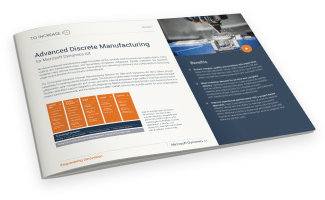Challenges of a Manufacturer Due to Lack of Visibility
 Eric Van Hofwegen
Eric Van Hofwegen
Table of contents
In today’s world, information is the currency that helps you stay ahead, and this is especially true of the business world. For manufacturing companies, this means complete and comprehensive visibility into the operations to ensure that all departments are working in tandem. In this article, we will look at the challenges that you may face as a manufacturer when you do not have visibility into the company and how discrete manufacturing solutions can help.
Some of the main challenges that you, as a manufacturer, can face due to lack of visibility include:
Lack of company-wide visibility: If your business is still using traditional tools to collect vital data for sales and marketing purposes, there is a good chance that you may not get a comprehensive view. Such a situation is more likely to happen when you have different departments working in silos. With an integrated solution that syncs with your ERP, all the departments have complete visibility, and the data they share has a commonality that helps in decision making.
Different systems that are not integrated: When you have disparate systems that have no integration, then the lack of connectivity can result in lack of a single source of truth. The way forward in such a situation is to ensure that systems are integrated. In the manufacturing context, consider the lack of integration between PLM and ERP. The result would be improper manufacturing as engineering change orders would not be found, inventory would not be right, and there would be numerous gaps. The integration of systems would bridge the gap between various activities like delivery and production, inventory and manufacturing, and so on. System integration also helps make sure that the information available to different teams in real-time.
Disconnect in processes: While there are numerous debates among different departments on the importance of their function in the company, it is crucial to ensure that there is a unification of processes. If anything, each department needs to have a complete view of the process path other departments take. When this happens, the commitments given to the end customers are based on scientific estimates rather than on assumptions. With the right solution in place, you would be able to create a centralized repository of information to align roles, processes, and technology towards the goals of your company.
Poor upkeep of assets: Most businesses have a lot of dependence on the assets they have, and this is especially true of manufacturing companies. Therefore, it is essential to ensure that all assets are maintained in good condition. This, in turn, means proper planning of manufacturing or usage and downtime to enable service and repairs. When you have a solution in place that allows you to have updated information on different assets, planning these activities becomes more effortless. Not only can you maximize asset productivity, but you can also control costs and make sure you are meeting customer commitments. With data coming in different assets, you can even schedule predictive maintenance for high-end and critical assets. This is the right way to ensure the longevity of the asset and to manage capital expenses.
Today, we are in a connected and technologically-advanced world where we can leverage the right solution to deal with challenges due to lack of visibility. You can benefit from tools to model your business tools, accurate data that is available real-time, and service-oriented architecture to help your business grow and thrive.
Want to learn how we can help you manage your production, deliver innovative products, and digitally transform your business?
Learn how our Manufacturing Integration solution can help you!


